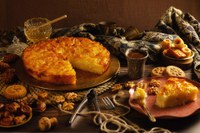Prairie Fare: Tempering a sweet tooth during holiday festivities
(Click an image below to view a high-resolution image that can be downloaded)
A few years ago, my kids informed me that they really didn’t like turkey all that much.
I had a 15-pound turkey thawing in the refrigerator for Thanksgiving dinner. We had turkey for dinner.
My kids primarily liked the mashed potatoes, stuffing and pumpkin pie. Fortunately, leftover turkey freezes well.
The next year I made a large roasting hen. Having a chicken instead of turkey resulted in no leftovers.
What are your family’s favorite foods during holidays? We don’t all share the same cultural traditions and preferences. We may celebrate a variety of holidays. Even among traditional Thanksgiving celebrations, sometimes a turkey is not the centerpiece.
We are entering a couple of months filled with opportunities to enjoy various foods, and sweets often play a prominent role.
People of Scandinavian descent tend to like their sweets. I have an entire cookbook of Scandinavian sweets. “Kransekake” may be the preferred dessert. It’s an almond-shaped layered cake that looks like a tree.
If you celebrated in Peru, you might be enjoying sweetened hot chocolate with the addition of spices.
Those celebrating Hanukkah might enjoy latkes, a fried potato pancake with onion, egg, and matzo or breadcrumbs. They are often topped with sweetened applesauce.
If you lived in the United Kingdom, plum pudding may be the dessert course. Sometimes a coin is baked into the pudding. When I read about the coin, “choking hazard” came to my mind.
In France, you might have “Buche de Noel.” That’s a cake shaped and decorated to look like a yule log.
As you may have noticed, many holiday traditions center around the “treats.”
I recognize the appeal of sweet foods. Our collective sweet tooth probably saved our distant ancestors. Sweet foods found when foraging were safe to eat. Poisonous plants typically are bitter, so our ancestors steered clear of eating them, and we exist as a result.
Besides adding flavor, sugar plays a role in preserving food and providing texture. The browning of caramel candies, for example, is made possible by the addition of sugar. Cookies become light brown as a result of the chemical interaction of sugar, protein and heat. The browning also provides flavor.
The sugar in yeast bread recipes provides food to the yeast, so the dough rises. Most jams and jellies are at least partially preserved by the sugar they contain.
Unfortunately, we typically eat more than the recommended amount of added sweeteners during the holidays and all year long. On average, many people eat the equivalent of 60 pounds of sugar annually.
The latest version of Nutrition Facts labels includes “added sugars.” Read and compare labels. The American Heart Association recommends no more than 100 calories, or 6 teaspoons, of added sugars for women and not more than 150 calories of added sugar for men.
Regardless of your preferred sweet treat, be sure to slow down and enjoy what you are eating. Remember that it takes your brain a while to get the idea that your stomach is full. Have a piece of pumpkin pie or enjoy your favorite cookie, but avoid having two servings of each.
Choose naturally sweet fresh fruit. Try a fruit salad, dip, kabobs or parfait cup. Kiwis, oranges, persimmons, mandarins, apples, pears and grapefruits are some fruits that are in season in the U.S. during December. Many of these are delicious with a yogurt-based dip or make a great winter fruit salad.
Eat before the party. Sugary foods can be devoured easily when you are hungry. Make sure to eat a small meal or snack, such as soup, before heading to holiday gatherings. If this isn’t an option for you, try snacking on the meat, cheese or veggie tray before stopping by the cookie tray.
Drink plenty of water or fruit-infused water. The Journal of Human Nutrition and Dietetics examined the dietary benefits of consuming plain water. They found that drinking more plain water was associated with reduced overall calories, and reduced sugar-sweetened beverages and other discretionary foods.
Here's a high-water, refreshing dessert after a heavy meal.
Grape Sorbet
3 cups frozen seedless green or red grapes
1 tablespoon fresh mint
3 tablespoons honey
2 teaspoons fresh lemon juice
Pinch of coarse salt
Place grapes in a food processor with mint, honey, lemon juice and salt. Puree. Place in freezer until firm, at least four hours.
Each serving has 130 calories, 0 grams (g) fat, 1 g protein, 34 g carbohydrate, 1 g fiber and 65 milligrams sodium.
(Julie Garden-Robinson, Ph.D., R.D., L.R.D., is a North Dakota State University Extension food and nutrition specialist and professor in the Department of Health, Nutrition and Exercise Sciences.)
NDSU Agriculture Communication – Nov. 16, 2023
Source: Julie Garden-Robinson, 701-231-7187, julie.garden-robinson@ndsu.edu
Editor: Elizabeth Cronin, 701-231-7881, elizabeth.cronin@ndsu.edu




